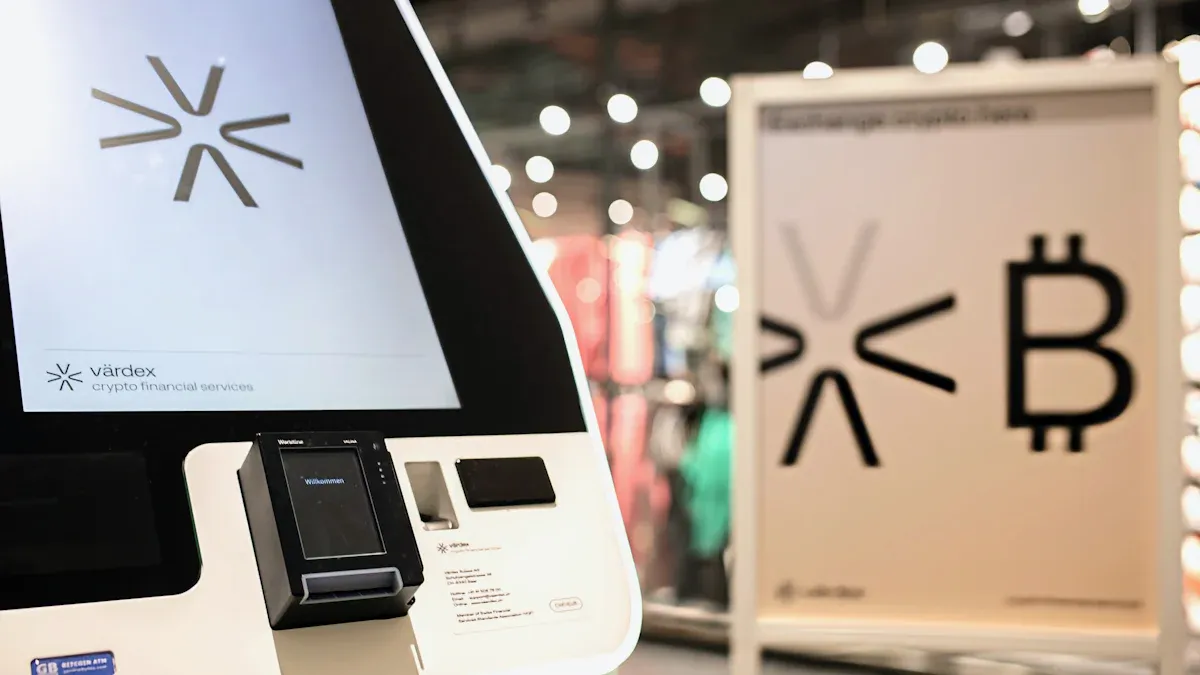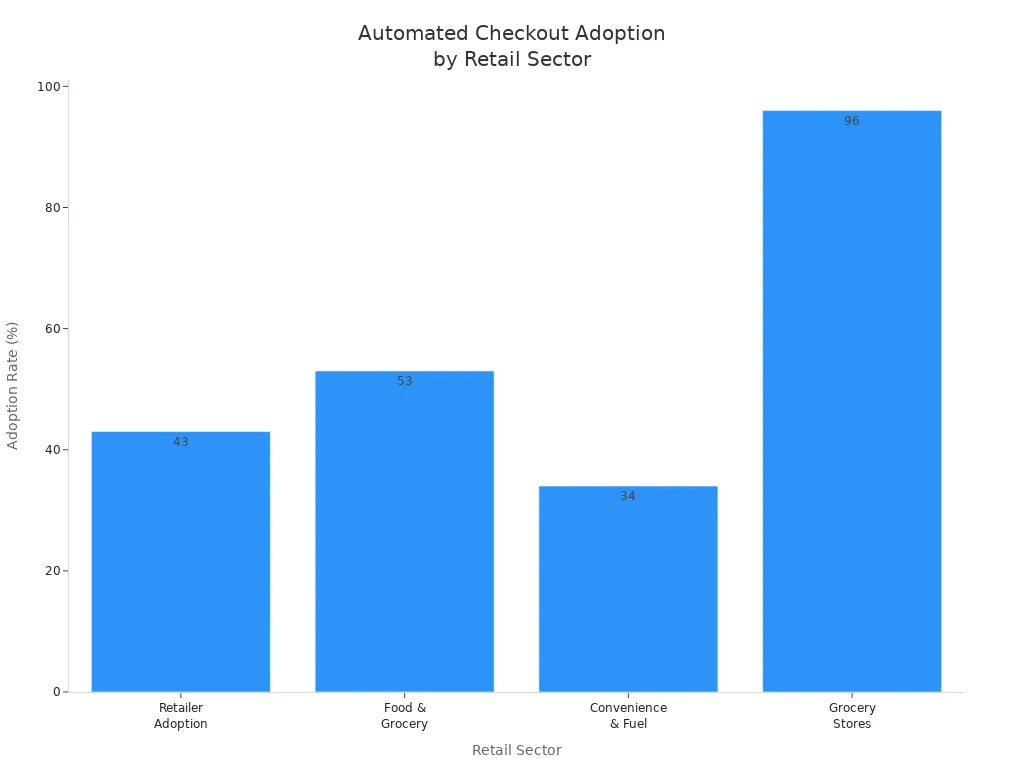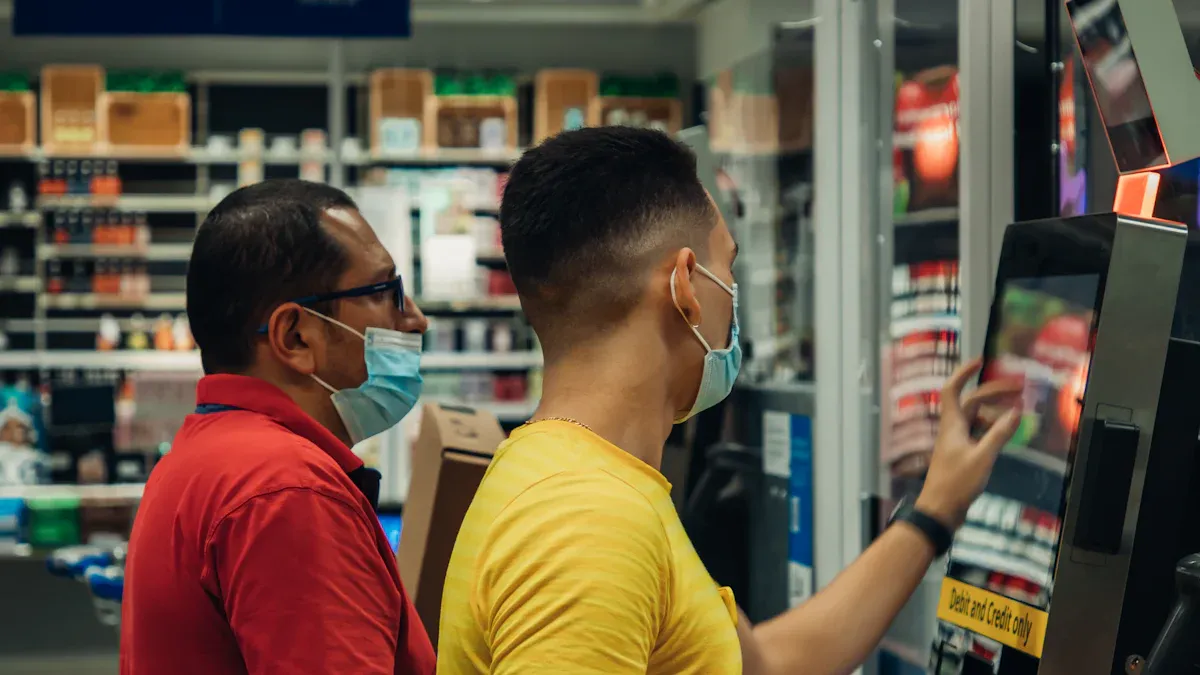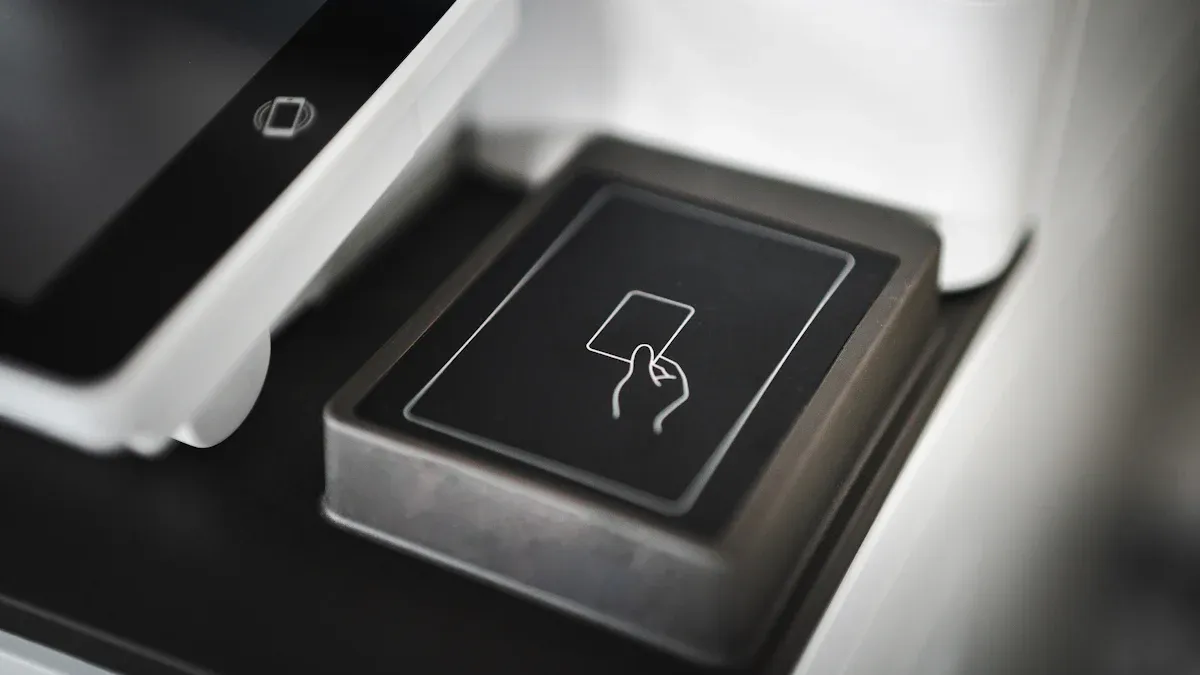What You Need to Know About Automated Checkout Hardware and What Does it Concern Safety Measures

Automated checkout and self-checkout systems have changed shopping. Many stores now use these systems. You can see this in the table below:
Sector | Adoption Rate | Future Plans |
|---|---|---|
Retailer Adoption | 43% | 17% want to use more |
Food & Grocery | 53% | Not available |
Convenience & Fuel | 34% | 37% testing or using more |
Grocery Stores | 96% | 24,000 stores by 2030 |
Recent Search Interest | Not available | More interest in May 2025 |

“Self-checkout machines also make stealing easier. This means more shoplifting and less safety for us.” - Aurora Hernandez, cashier at Food 4 Less.
Younger people like using these systems more. The size of the store matters too. What is sold in the store also matters. People should learn about this technology. They should know its parts and any dangers. Hardware and software are both important. AI and recognition tools help keep these systems safe and fast.
Key Takeaways
Automated checkout systems make shopping faster. Customers scan and pay for items by themselves. This can cut wait times by almost half.
Safety measures use AI technology and weight sensors. These help stop theft and make sure transactions are correct. This keeps shopping safe for everyone.
Retailers need to check and fix their checkout systems often. This helps prevent problems and makes shopping better for customers.
Customers help keep things safe by following instructions. They should also know the store rules for self-checkout.
Learning about automated checkout technology helps shoppers feel at ease. It also makes them more sure when using these systems.
Automated Checkout and Self Checkout Systems

What Is Automated Checkout?
Automated checkout is when technology does the cashier’s job. It uses hardware and software to scan items and take payments. It also keeps track of what is in the store. There are different ways automated checkout works. Some stores have self checkout machines. These let customers scan and pay for their own things. Other stores use advanced systems. Shoppers can just walk out, and the store charges them automatically.
Automated checkout and self checkout are not the same:
With self checkout, customers scan each item by themselves. This can take longer and sometimes annoy people.
Checkout-free automated checkout lets people leave without stopping at a register. This makes shopping faster and easier for them.
Self checkout can lead to more stealing. Studies show theft can be twice as high as with regular checkouts. Checkout-free automated checkout helps stop theft. It controls who comes in and watches what people buy.
Some shoppers think self checkout is hard to use. Automated checkout with better technology makes things easier. It cuts down wait times and makes shopping smoother.
Retailers pick automated checkout to make fewer mistakes. It helps them keep track of things in real time. It also helps them follow rules and manage their stuff better.
How Self Checkout Systems Work
Self checkout systems use machines and kiosks. These let customers buy things on their own. Both customers and stores have steps to follow. The table below shows the main steps:
Step | Summary |
|---|---|
1. Assess Business Needs | Stores look at how they work and what customers do. They check for problems and think about costs and what people like. |
2. Select the Right Solution | Stores pick self checkout systems that fit their needs and budget. |
3. Integrate with Existing Infrastructure | The system connects to other store tools. These include point-of-sale, payment, and loyalty programs. Stores test to make sure it all works. |
4. Set Up Payments | Stores offer ways to pay like cash, card, or contactless. They keep customer data safe and handle different payment types. |
5. Consider User Experience and Accessibility | Stores design kiosks to be easy for everyone. They use clear screens and add features for people with special needs. |
6. Beef Up Security and Loss Prevention | Stores use cameras, supervisors, and AI to stop stealing. They try to keep things safe but still easy for shoppers. |
7. Test and Gather Feedback | Stores try out self checkout in some places first. They ask for feedback and look at data to make things better. |
8. Implement Rollout and Marketing Plan | Stores add self checkout slowly. They teach customers about the benefits, like faster shopping and rewards. |
9. Stay on Top of Maintenance and Upgrades | Stores keep machines working well. They update software and hardware and add new features for a better experience. |
Self checkout systems help stop mistakes. They make buying things faster and more correct. Automation helps stores keep better records and make smart choices.
Types of Installations
Stores can pick from different automated checkout and self checkout kiosks. The choice depends on how big the store is and what customers want. The table below compares common types:
Retail Environment | Typical Price Range (USD) | Notes on Influencing Factors |
|---|---|---|
Standing Retail Self-Checkout Kiosks | $2,000 - $15,000 | Price changes with hardware and software quality. |
Self-Service Order and Pay Kiosks | $1,500 - $20,000 | Cost depends on what features are included. |
Ticketing Self-Service Kiosks | $1,500 - $10,000+ | More features mean higher prices. |
Basic Models | Starting around $1,500 | These are simple machines with fewer features. |
Advanced Systems | Exceeding $20,000 | These have RFID and better software. |
Freestanding kiosks are harder to install.
Countertop machines are easier to set up.
Integration includes hardware, software, and updates.
Grocery stores and supermarkets use regular self checkout machines. Smart vending machines and unmanned stores use advanced automated checkout. For example, Cloudpick’s Unmanned Store lets people shop without scanning or waiting. AI tracks what people buy and helps stop theft. It works all day. Starbucks uses Amazon’s system for grab & go coffee shops. Customers order on an app and pick up coffee without a regular checkout.
Automated checkout and self checkout have many good points:
People spend 20–40% more in stores with automated checkout.
77% of shoppers like self-service.
Self checkout makes buying things 30% faster.
Wait times can drop by up to 40%.
Labor costs go down by 15–30%.
RFID makes inventory almost perfect at 99%.
Stores face problems when adding self checkout and automated checkout. Long lines and not enough space can upset customers. Mobile self checkout helps cut wait times and lets workers help more. These systems take many payment types and help stores give better service. Automation cuts mistakes and builds trust. But high costs and more theft are still problems. Stores use receipt checks and lock up items that get stolen a lot.
Automated checkout and self checkout are growing in stores. They help stores work better, save money, and make shopping nicer.
Key Hardware Components
Automated checkout systems need several main parts. Each part helps make shopping faster and safer. The table below lists the main parts and what they do:
Component | Function |
|---|---|
Built-In Product Scanner | Scans items with barcodes or computer vision. Customers scan items themselves. |
Weight Sensors and Smart Scales | Checks item weight and placement. This helps stop mistakes and fraud. |
Touchscreens or Mobile Interfaces | Lets customers see their cart, use coupons, and manage items right away. |
Payment Integration | Allows many ways to pay, like contactless and digital wallets. |
Barcode Scanners and Card Readers
Barcode scanners help stores check out items fast. They read codes much quicker than typing numbers. This makes lines shorter and lets workers help more. Card readers let people pay with cards or phones. This makes checkout easy and safe.
Barcode readers help stores save money by making fewer mistakes. They track inventory in real time. This keeps stock levels right and helps restock on time.
Some good things about barcode scanners and card readers are:
Scanning is faster than typing numbers. Checkout goes quicker.
Fewer mistakes happen, so prices and product info stay correct.
Stores use these tools to track sales, order more products, and make reports.
AI Recognition Technology
AI recognition technology uses smart programs to spot products. It can find items even without barcodes. This helps stores watch inventory all the time. Staff get alerts when stock is low. AI also keeps checkout safe by finding errors or fraud.
AI recognition technology uses smart programs to spot products.
It helps stores watch inventory and restock quickly.
The technology finds fraud, like scanning mistakes or cheating.
User Interfaces
User interfaces are touchscreens and mobile apps. These let customers see their cart, use coupons, and pay easily. Good interfaces make checkout simple for everyone. This helps people who do not use technology much.
Evidence | Description |
|---|---|
Speed of Service | Fast checkout makes customers happy and service better. |
Technology Usability | Easy screens and good hardware make customers like shopping more. |
Accessibility Challenges | Some people find new tech hard, so stores must keep it simple. |
When self-checkout works well, customers come back more often. Stores should keep screens easy and fix problems fast to build trust.
Equipment Checkout Software and System
Software Features
Equipment checkout software helps stores keep track of items. It makes sure things are safe and not lost. The software watches every item that comes in or goes out. It sends alerts when something needs to be returned or checked for problems. Many systems now let people use their phones to check items in or out. They use QR codes or NFC for this. This makes things faster and safer for workers and shoppers. The table below lists some key features:
Feature | Description |
|---|---|
Real-time tracking of asset availability | Gives up-to-date info on what is in stock. This stops double bookings. |
Automated notifications for returns and maintenance | Sends reminders about when to pick up or return items. It keeps users updated. |
Mobile check-in/check-out via QR codes or NFC technology | Lets people check items in or out with their phones. It is quick and touch-free. |
This software also keeps private data safe. It uses secure logins and hides information. This lowers the chance of theft or loss. Stores can trust this software to keep their inventory right and protect customers.
Integration and IT Management
Equipment checkout software works best when it connects to other store systems. Linking with payment, inventory, and loyalty programs helps stores run better. When the software joins with the store’s IT setup, it brings many good things:
Better user experience: Pages load fast and show what is in stock. This makes shopping easier.
More uptime: The system keeps working even when it is busy. Stores do not miss sales.
Faster checkout: Payment systems handle many sales at once. Customers do not have to wait long.
Personal touch: The software handles lots of customer data. It gives each shopper a special experience.
IT teams find this software easy to use. Updates and help work on many devices, like kiosks and phones. This helps stores grow and add new things.
Consistent Customer Experience
A steady customer experience builds trust and brings shoppers back. Equipment checkout software helps by giving the same process everywhere. Stores use different ways to make sure every customer has a good visit:
Strategy | Description |
|---|---|
Staff Training | Good training helps staff do well and help customers. |
System Testing | Testing before opening finds problems early. This makes things better for everyone. |
Phased Rollout | Rolling out slowly with special training helps the team adjust and support customers. |
Customer Communication | Talking clearly makes customers feel safe and want to use self-checkout. |
Omnichannel Retail | Gives a smooth experience in stores and online. This keeps things the same for everyone. |
This software helps staff answer questions and fix problems fast. It also works with self checkout software. Customers get the same service in the store or online. Stores that use these ideas see happier customers and fewer complaints.
Safety Measures and Security Concerns

Data Protection
Keeping customer data safe is very important for stores. Stores must follow strict rules to protect information. Many stores use smart ways to keep data safe. The table below shows some of the best ways:
Measure/Technology | Description |
|---|---|
GDPR Compliance | Makes sure stores follow data protection laws and avoid trouble. |
PCI DSS Compliance | Global rule for payment card safety, keeps payment info safe. |
HTTPS Encryption | Protects data when sent, so others cannot read it. |
Tokenization | Switches sensitive data with safe tokens to lower risks. |
Fraud Detection | Watches transactions live to find and stop bad actions. |
Stores use these good habits:
Encryption mixes up data so hackers cannot read it.
Tokenization swaps private info with special tokens to lower risks.
Fraud detection tools watch for strange actions and block them.
Stores use HTTPS on checkout pages. They show security badges to help shoppers feel safe. Stores only ask for the data they need. These steps help shoppers trust stores and keep their info safe.
Payment Security
Payment security keeps stores and shoppers safe. Checkout systems must handle payments safely and follow rules. Most stores use PCI DSS to keep card data safe. They use HTTPS to protect info during payments.
New systems use AI cameras to watch for strange actions. Weight and barcode checks help find mistakes or missing scans. Smart video cameras use object detection and remote viewing. AI sends alerts if something odd happens. Security systems work with checkout software to check every sale.
Stores use Shopic's Loss Prevention to spot errors and bad actions. This tech uses computer vision to lower fraud and keep checkout easy.
Surveys say 21% of shoppers have taken items by mistake at self-checkout. About 15% admit to stealing on purpose. Self-checkout can cause up to 23% of unknown store losses, with almost half from theft.
Physical Safety
Physical safety is important for shoppers and workers. Stores set up checkout systems to stop accidents. Kiosks need clear signs and space for people to move. Touchscreens and card readers should be easy for everyone to reach.
Stores follow ADA rules to make kiosks usable for all. They check that wires and machines do not trip people. Staff learn how to help shoppers use machines safely. Stores check and fix equipment often to stop breakdowns.
If a machine breaks, it can cause problems or long lines. Stores test systems often and fix issues fast to keep things smooth.
Fraud Prevention
Fraud prevention helps stores stop losses and keep shopping fair. Checkout systems use tools to stop theft and cheating. Fraud detection uses data mining, anomaly checks, and predictions. These systems use machine learning to find strange patterns.
With camera recognition, self-checkout can spot hand movements and see if someone tries to skip scanning. If an alert pops up, shoppers must fix the problem.
Ways to stop fraud include:
AI checks customer actions and flags possible theft.
Staff learn about theft tricks and report strange actions.
Strict refund and payment rules need ID checks and may block cash refunds.
Some stores use computer vision to catch people skipping scanners. AI checks receipts at exits. Cameras watch in real time and send alerts for odd actions.
The table below shows common security problems and how stores fix them:
Vulnerability Type | Description | Solutions |
|---|---|---|
Non-scanned items | Over 60% of losses; 3% of sales have missed scans. | AI, weight alerts, learning from data, making customers responsible. |
Misuse of price look up codes | Shoppers use cheap codes for pricey items, causing losses. | AI checks, staff training, better screens, talking to customers. |
Walk-off without payment | Shoppers leave without paying, causing losses and problems. | AI alerts, staff training, better user experience. |
Stores follow strict privacy and security rules like GDPR and CCPA. They check systems often and use clear data rules to build trust.
Focusing on safety and security helps stores protect their business and shoppers. The right checkout system uses tech, training, and clear rules for safer shopping.
Best Practices for Retailers and Customers
Retailer Guidelines
Retailers can make stores safer by following simple steps. They should use weight sensors to check if items match what is bagged. Staff or security should stay near self-service areas to help and stop fraud. Signs can remind shoppers that cameras watch the checkout process. Adding contactless payment and barcode checks makes self-service faster and helps stop missed scans.
AI systems help spot when customers forget to scan items. Vision AI can catch people switching barcodes for cheaper prices. If a customer leaves without finishing, the system alerts staff. These steps help track items and equipment, making self checkout safer for everyone.
Customer Safety Tips
Customers help keep self-service safe too. Stores should explain how to use self-service checkout and warn about shoplifting risks. Employees need training to help customers learn the rules and features. Customers should know stores may use identification or biometrics to lower anonymity. Some stores use respectful spot-checks with data analytics to stop theft.
Customers should follow instructions on the screen and check their items. They should use the barcode system for every product and keep receipts for tracking. When making reservations or loans, customers should use online self-service tools for a secure experience.
Maintenance and Updates
Regular maintenance keeps self-service and equipment systems working well. The table below shows how often stores should do key tasks:
Task Type | Frequency |
|---|---|
Major repairs | Once or twice a year |
Device inventory | Once or twice a year |
Data backups | Daily, weekly, or more often |
Software updates | As needed, part of routine |
Security updates should happen after any big changes. Skipping maintenance can cause problems:
Slow performance can make checkout take longer.
Security gaps may let people access the system without permission.
New technology can crash if updates are missed.
More downtime can mess up reservations and loans.
Fixing problems costs more if updates are skipped.
A strong automated way to manage loans and reservations needs regular care. Good equipment management and tracking help stores avoid mistakes and keep customers happy.
Automated checkout systems use special hardware and software to help people shop faster and safer. Stores keep things safe by using staff, strong security, and smart store layouts.
Description | |
|---|---|
Human Oversight | Staff watch for theft and help shoppers. |
Enhanced Security | Stores use computer vision and RFID to protect better. |
Layout Design | Open spaces and anti-theft tools help guide people and lower risks. |
New tools like AI and mobile payments help stores find problems fast and keep things working well. Shoppers and store workers should learn about these updates and follow good safety steps.
FAQ
What are automated checkout systems?
Automated checkout systems use technology to let customers pay without a cashier. These systems scan items and handle payments. They also keep track of what is in the store. Stores use them to make shopping quicker and cut down on mistakes.
How do self-checkout systems improve store safety?
Self-checkout systems use cameras and weight sensors to watch for theft. AI helps find errors and stops people from stealing. Staff keep an eye on these systems and help shoppers. Secure payment systems protect customer information.
What hardware do automated checkout systems need?
Automated checkout systems need barcode scanners and card readers. They also use touchscreens and weight sensors. Some systems have cameras and AI to spot products. Stores pick hardware based on what they need and how big they are.
How do stores keep customer data safe in these systems?
Stores use secure software and encrypted payment systems. These systems follow rules like PCI DSS and GDPR. Data protection uses tokenization and fraud detection. Stores update systems often to fix security problems.
What should customers do if a self-checkout system has a problem?
Customers should ask staff for help if something does not work. Stores train workers to fix problems fast. Most systems show clear instructions on the screen. Stores check and fix systems often to stop issues.
See Also
Understanding Self-Checkout Cash Mistakes: Fixes for Easy Payments
Upcoming Changes to Walmart Self-Checkout Access in 2025
Walgreens Self-Checkout: Benefits and Hurdles in Shopping
How Self-Checkout Systems Have Developed Over Time
The Dangers of Vending Machines: Essential Safety Information
